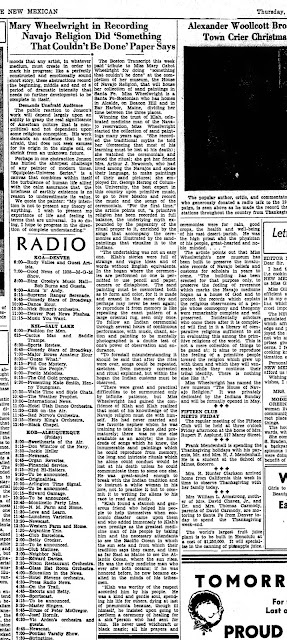1937: Mary Wheelwright in Recording Navajo Religion Did 'Something That Couldn't Be Done' paper says
1949, Dec 23 Wilmington News Journal
The Boston Transcript this week paid tribute to Miss Mary Cabot Wheelright for doing "something that couldn't be done" at the completion of her museum, the House of Navajo Religion, that will house her collection of sand paintings in Santa Fe. Miss Wheelwright is a Santa Fe-Bostonian who has homes in Alcalde, on Beacon Hill in Bar Harbor, Maine, dividing her time between the three places.
Winning the trust of Klah, celebrated medicine man of the Navajo reservation, Miss Wheelwright started the collection of sand paintings many years ago. "She recorded the traditional myths he told her (foreseeing that most of this learning must be lost at his death); she watched the ceremonials, and noted the ritual; she got her friend Mrs Arthur J Newcomb, who had lived among the Navajos and spoke their language, to make paintings of their sand pictures; she employed Dr. George Herzog of Columbia University, the best expert in this country upon primitive music, to go to New Mexico and record the music and the songs of the ceremonials. "For the first time," the article points out, "a primitive religion has been recorded in full balance, the underlying myth expounded by the pageantry of the ritual proper to it, enriched by the songs that accompany the ceremonies and illustrated by the sand paintings that visualize it to the Indians.
"The undertaking was not an easy one. Klah's stories were full of strange and vague ideas and of words without English equivalents. In the hogan where the ceremonies are performed no one is permitted to use pencil and paper camera or Dictaphone. The sand painting must be memorized both as to form and color, for it is made and erased in the same day and perhaps may never be seen again; to reproduce it from memory is like repeating the exact pattern of a large oriental rug, seen only once. To follow an Indian ceremonial through several hours of continuous performance, with music, chant, action and painting to be mentally photographed is a double test of one's power of observation and endurance.
"To forestall misunderstanding it should be said that after the rites were over, songs could be repeated, sketches from memory corrected and ritual explained, but within the hogan the Indian customs must be observed.
"There were great and practical difficulties to be surmounted only by infinite, patience, but Miss Wheelwright had gained the confidence of Klah and Klah realized that most of his knowledge of the Navajo religion must die with himself. He had never married and the favorite nephew whom he was training to take his place, died prematurely; there was no one else available as an acolyte; the hundreds of songs which he knew, the innumerable sand paintings which he could reproduce from memory, the long and intricate rituals which he alone could conduct would be lost at his death unless he could communicate them to some one else. He was great - souled enough to break with the Indian tradition and to instruct a white woman in his lore, not to practice it but to commit it to writing for aliens to his race to read and study.
"Klah found a staunch and generous friend who helped his people to help themselves when economic disaster came upon them and who added immensely to Klah's own prestige as the greatest medicine man of his people by taking him and the necessary attendants to see the Pacific Ocean in which the sun sets and from which their tradition says they came, and then as far East as Maine to see the Atlantic Ocean, where the sun rises. He was the only medicine man who ever saw both oceans; if he was honored before, he now became exalted in the minds of his tribesmen.
"Klah was worthy of the respect accorded him by his people. He was a kind and gentle soul, spending his life for others, dying at last of pneumonia because, though ill himself, he insisted upon going to perform a ceremony of healing for a sick person who had sent for him. He never used witchcraft or black magic; all his prayers and ceremonies were for rain, good crops, the health and well-being of his vast desert parish. He was the high priest and the physician of his people, great-hearted and noble minded. . . . "
The article points out that Miss Wheelwright's new museum has been built to preserve the invaluable records of Navajo beliefs and customs for scholars in years to come. "The building has been erected for that purpose only, to preserve the feeling of reverence which marks the Navajos medicine hogan as house of God and to protect the records which explain the religious observances of a people whose cosmogony and theogony were remarkably complete and well preserved. Incidentally scholars who come there after it is completed will find in it a library of comparative religions sufficient to aid in evaluating this among the primitive religions of the world. This is not a mere collection of things to be gazed at; it aims to reproduce the feeling of a primitive people toward the religion which grew up with them and which they will venerate while they continue their tribal identity. There is nothing else like it."
 |
| 1949, Dec 23 Wilmington News Journal |


